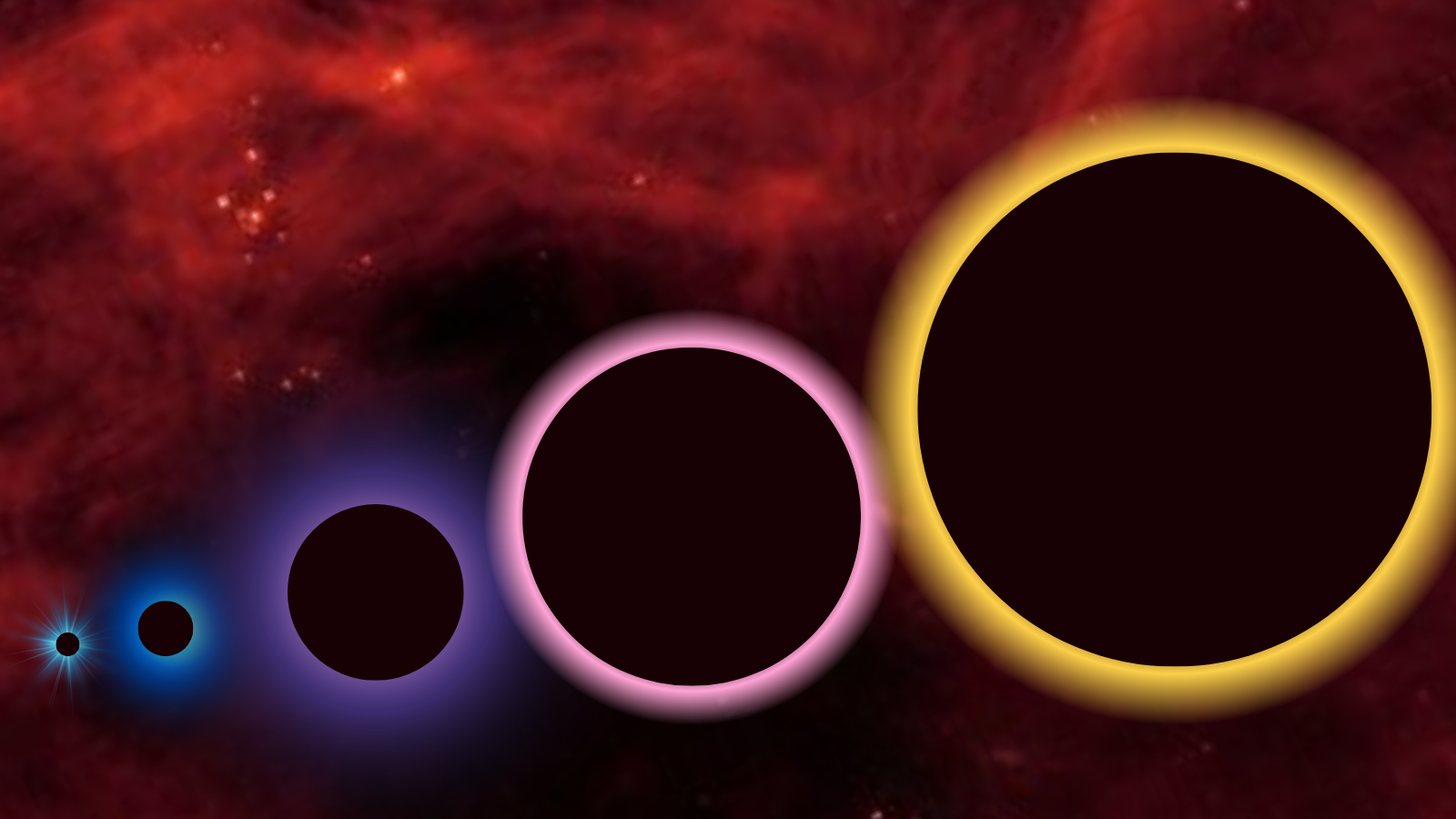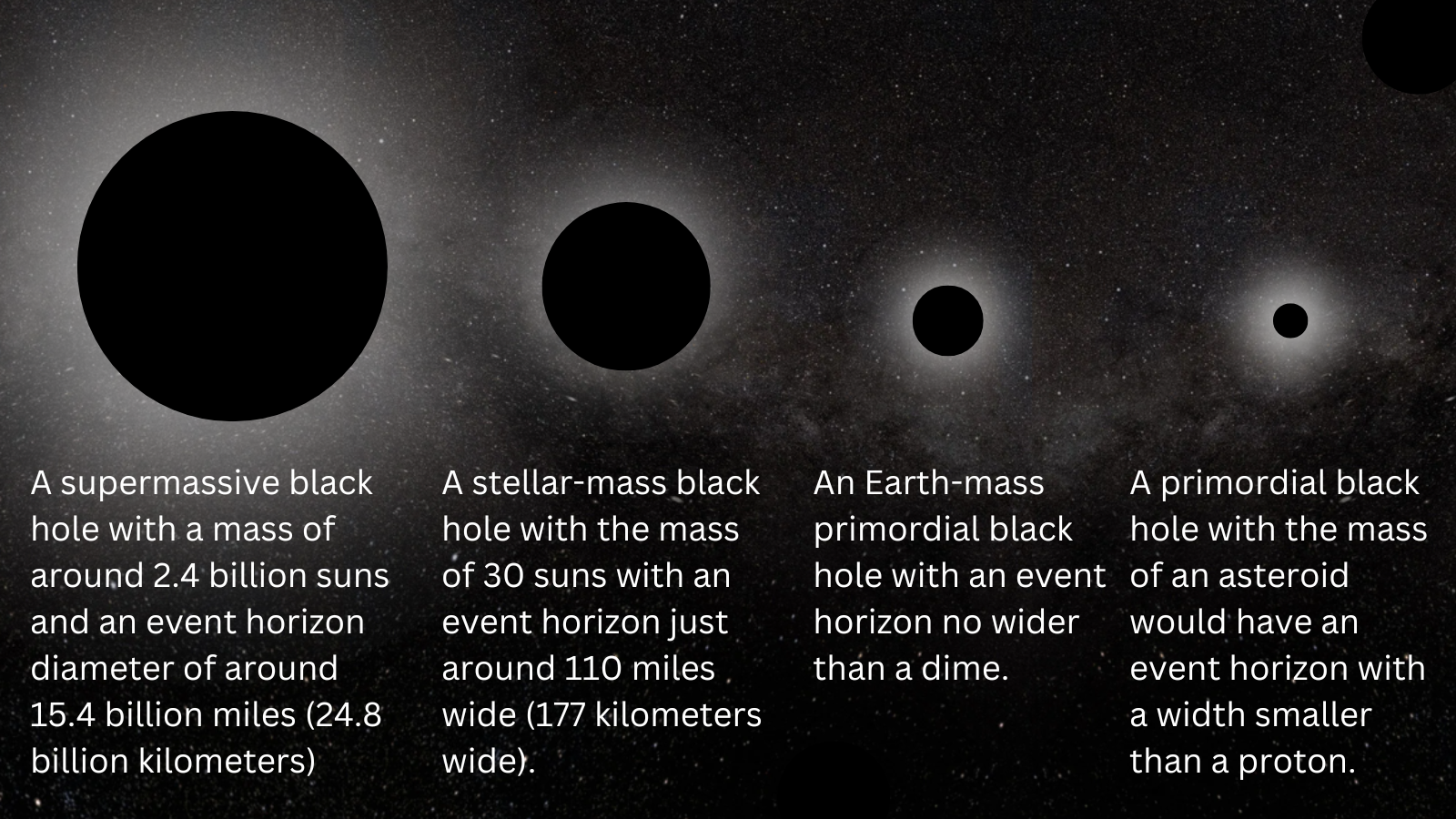
Primordial black holes that formed during the earliest moments of the universe could have swollen quickly to supermassive sizes, complex cosmological simulations have revealed.
The discovery could lead to a solution for one of the biggest problems in modern cosmology: how supermassive black holes could have grown to be millions or billions of times more massive than the sun before the universe was 1 billion years old.
This problem has gotten out of hand recently, thanks to NASA's James Webb Space Telescope (JWST). The powerful scope has been probing the early universe, discovering more and more supermassive black holes that existed just 700 million years after the Big Bang, or even earlier.
"The problem here is that, when we view the early universe with more and more powerful telescopes, which effectively allow us to see the cosmos as it was at very early times due to the finite speed of light, we keep seeing supermassive black holes," research team member John Regan, a Royal Society University research fellow at Maynooth University in Ireland, told Space.com. "This means that supermassive black holes are in place very early in the universe, within the first few hundred million years."
The processes that scientists previously proposed to explain the growth of supermassive black holes, such as rapid matter accretion and mergers between larger and larger black holes, should take more than a billion years to grow a supermassive black hole.
The earliest and most distant supermassive black hole discovered thus far by JWST is CEERS 1019, which existed just 570 million years after the Big Bang and has a mass 9 million times that of the sun. That's too big to exist 13.2 billion years or so ago, according to the established models.
"This is confusing, as the black holes must either appear at this large mass or grow from a smaller mass extremely quickly," Regan said. "We have no evidence to suggest that black holes can form with these huge masses, and we don't fully understand how small black holes could grow so rapidly."
The new research suggests that primordial black holes could have given early supermassive black holes a head start in this race.
Non-astrophysical black holes get a head start
Black holes come in an array of different masses. Stellar-mass black holes, which are 10 to 100 times heftier than the sun, are created when massive stars exhaust their nuclear fuel an die, collapsing to trigger huge supernova explosions.
Supermassive black holes have at least one million times the mass of the sun and sit at the heart of all large galaxies. They're too large to be formed when a massive star dies. Instead, these black holes are created when smaller black holes merge countless times, or by ravenously feeding on surrounding matter, or in a combination of both processes.
These two examples of black holes, as well as elusive intermediate-mass black holes, which sit in the mass gulf between stellar-mass and supermassive black holes, are classed as "astrophysical" black holes.
Scientists have long proposed the existence of "non-astrophysical" black holes, in the form of primordial black holes. The "non-astrophysical" descriptor refers to the fact that these black holes don't rely on collapsing stars or prior black holes for their existence.
Instead, primordial black holes are proposed to form directly from overdense pockets in the soup of steaming-hot matter that filled the universe in the first second after the Big Bang.

There is no observational evidence of these primordial black holes thus far. However, that hasn't stopped scientists from suggesting that these hypothetical objects could account for dark matter, the mysterious "stuff" that accounts for 85% of the matter in the universe but remains invisible because it doesn't interact with light.
The new research suggests that primordial black holes, proposed to have masses between 1/100,000th that of a paperclip and 100,000 times that of the sun, could have a big advantage in rapidly forming supermassive black holes. That's because the upper limit on their mass isn't restricted by how massive a star can get before it dies, as is the case with stellar mass black holes.
"Primordial black holes should form during the first few seconds after the Big Bang. If they exist, they have some advantages over astrophysical black holes," Regan said. "They can, in principle, be more massive to begin with compared to astrophysical black holes and may be able to settle more easily into galactic centers, where they can rapidly grow."
Primordial black holes can also get a head start on stellar-mass black holes, because they don't have to wait for the first generation of massive stars to die — a process that could take millions of years.
Regan explained that, due to their origins, astrophysical black holes can form only after the first stars run out of fuel. Even then, astrophysical black holes can still be just a few hundred solar masses in total. Additionally, negatively impacting the prospect of supermassive black hole growth from stellar-mass black holes is the fact that the energy emitted from stars during their lives and their explosive supernova deaths clears material from around the newborn black holes, depleting their potential larder and curtailing their growth.
"That can mean that there is no material for the baby black hole to accrete," Regan explained.
Primordial black holes wouldn't emit energy and wouldn't "go 'nova, eliminating this hindrance. But, they would still need to find their way to an abundant source of matter.
Do primordial black holes go supermassive at the heart of galaxies?
In the simulation performed by Regan and colleagues, primordial black holes needed to grow by accreting matter, with black hole mergers taking a backseat in the process.
"Matter in the early universe is mostly composed of hydrogen and helium," Regan continued. "These primordial black holes are expected to mostly grow by accreting hydrogen and helium. Mergers with other primordial black holes may also play a role, but accretion is expected to be dominant."
For the matter accretion of primordial black holes to be efficient enough to result in the creation of supermassive black holes, these objects need to be able to rapidly gobble up matter. That means making their way to regions of the universe where matter congregates — namely, the center of galaxies, which also happens to be where supermassive black holes lurk in the modern epoch of the cosmos.
"For this, primordial black holes need to sink to the center of a galaxy," Regan said. "This can happen if there are enough primordial black holes. Only a few have to get lucky!"
The number of primordial black holes available for this process determines whether astrophysical black holes would eventually play a role in the growth of early supermassive black holes.
"If primordial black holes are very abundant, then they can make up the whole supermassive black hole population," Regan said. "Whether primordial black holes account for the entire mass of early supermassive black holes depends on how many there are. In principle, it's possible, but my guess is that astrophysical black holes play a role, too."

Of course, these findings are based on simulations, so there is a long way to go before this theory can be confirmed. One line of observational evidence for this theory would be the detection of a massive black hole in the very, very early universe, prior even to 500 million years after the Big Bang.
Another possible line of observational evidence would be the detection of a black hole with a mass smaller than three times that of the sun in the modern-day universe. That's because no black hole so small could have formed from the supernova death and collapse of a massive star, indicating this diminutive black hole grew from a primordial one.
"I was surprised that primordial black holes grew so rapidly and that our simulations at least matched the parameter space in which they can exist," Regan said. "All we need now is a 'smoking gun' of a primordial black hole from observations — either a very low-mass black hole in the present-day universe or a really high-mass black hole in the very early universe.
"Primordial black holes, if they exist, will be hiding in the extremes!"
In lieu of such observational evidence, the team will seek to improve their cosmological simulations to strengthen the theory of supermassive black holes starting off as primordial black holes.
"The next steps are to increase the realism of the simulations. This was a first step. The simulations only had primordial black holes," Regan concluded. "Next, we want to model primordial and astrophysical black holes in the same environment and see if we can see any distinguishing characteristics."
The team's research appears as a pre-peer review paper on the repository site arXiv.







